即使是伟大的数学家也会犯错误
We know that math is a science of precision. Can we say the same about GeoGebra, an interactive math learning software? Let's analyze the project source code using PVS-Studio!

Introduction
Do you remember how you learned computer science at university? All these matrix and vector multiplications, polynomial equations, interpolation, extrapolation... What if we look at these scary formulas in a real project, rather than in another lab report? What if we dig for issues in such a code base? I suggest running PVS-Studio and dusting off math textbooks. Why textbooks? Let me show you.
Math challenges
One of the main challenges in examining the source code of such programs is to understand what's going on. When reviewing the analyzer report, we've had questions whether the warnings indicate real issues.
Let's take a look at the following fragment:
@Override
public void compute() {
....
if (cumulative != null && cumulative.getBoolean()) {
....
} else {
....
branchAtoMode = fv.wrap().subtract(a).multiplyR(2)
.divide(bEn.subtract(a).multiply(modeEn.subtract(a)));
branchModeToB = fv.wrap().subtract(b).multiplyR(2)
.divide(bEn.subtract(a).multiply(modeEn.subtract(b)));
rightBranch = new MyDouble(kernel, 0);
}
....
}
We get the following PVS-Studio warning:
V6072 Two similar code fragments were found. Perhaps, this is a typo and 'b' variable should be used instead of 'a'. AlgoTriangularDF.java 145, AlgoTriangularDF.java 146, AlgoTriangularDF.java 147, AlgoTriangularDF.java 148
Is it really a typo? After a quick research, and once we found the right formula, we can say that everything is written correctly.
The code fragment evaluates the triangular distribution, i.e. the probability density function (PDF) for this distribution. We found the formula:
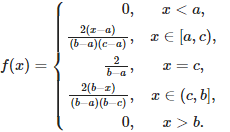
Now let's go through the code.
Here,* fv* is a function variable. wrap returns wrapper, and then the necessary mathematical operations are performed. It's interesting to note that there are both multiply and multiplyR methods. In the second method, R stands for right and swaps operands, as multiplication is not always commutative.
So, the second expression result is written to branchAToMode, and the fourth expression is written to branchModeToB.
We also noticed that in branchModeToB, the signs for the numerator and denominator have been changed. We get the following expression:

The expression value didn't change.
So, we refreshed our mathematical knowledge to understand some of the warnings we received. It's not hard to identify if there is a real error in the code, but it's hard to understand what it's supposed to be here instead.
Errors
Lost code segment
Let's start simple and look at the following method:
private void updateSide(int index, int newBottomPointsLength) {
....
GeoSegmentND[] s = new GeoSegmentND[4];
GeoSegmentND segmentBottom = outputSegmentsBottom.getElement(index);
s[0] = segmentBottom;
s[1] = segmentSide1;
s[2] = segmentSide2;
s[2] = segmentSide3;
polygon.setSegments(s);
polygon.calcArea();
}
We see that someone has forgotten to replace s[2] with s[3]. The last line effect is in all its brilliance. It's the legendary and all-too-common copy-paste error. As a result, the fourth array item is missing and is null!
V6033 An item with the same key '2' has already been changed. AlgoPolyhedronNetPrism.java 376, AlgoPolyhedronNetPrism.java 377
What about values?
Now try to spot the issue in the following code snippet:
static synchronized HashMapgetGeogebraMap() { .... geogebraMap.put("−", "-"); geogebraMap.put("⊥", "# "); geogebraMap.put("∼", "~ "); geogebraMap.put("′", "# "); geogebraMap.put("≤", Unicode.LESS_EQUAL ""); geogebraMap.put("≥", Unicode.GREATER_EQUAL ""); geogebraMap.put("∞", Unicode.INFINITY ""); .... geogebraMap.put("∏", "# "); geogebraMap.put("∏", "# "); geogebraMap.put("〉", "# "); geogebraMap.put("⟩", "# "); geogebraMap.put("→", "# "); geogebraMap.put("⇒", "# "); geogebraMap.put("⟩", "# "); geogebraMap.put("→", "# "); geogebraMap.put("⇒", "# "); geogebraMap.put("→", "# "); geogebraMap.put("⋅", "* "); geogebraMap.put("∼", "# "); geogebraMap.put("∝", "# "); geogebraMap.put("∝", "# "); geogebraMap.put("∝", "# "); geogebraMap.put("⊂", "# "); .... return geogebraMap; }
What a magnificent view! It's a joy to read, and this is only a small part because this method starts on line 66 and ends on the 404th. The analyzer issues 50 warnings of the V6033 type. Let's take a quick look at one of these warnings:
V6033 An item with the same key '"∼"' has already been added. MathMLParser.java 229, MathMLParser.java 355
Let's remove the superfluous fragments and look at the expressions referred to the warning:
geogebraMap.put("∼", "~ ");
....
geogebraMap.put("∼", "# ");
It's interesting, though. What is the spacing between the method calls? There are 126 lines. Well, good luck finding such an error by hand!
Most are duplicates in key and value. However, a few cases are similar to the example above, where developers overwrite the value with a different one. Which one should we use?
Circles or ellipses
@Override
protected boolean updateForItSelf() {
....
if (conic.getType() == GeoConicNDConstants.CONIC_SINGLE_POINT) {
....
} else {
if (visible != Visible.FRUSTUM_INSIDE) {
....
switch (conic.getType()) {
case GeoConicNDConstants.CONIC_CIRCLE:
updateEllipse(brush); //
The method for the ellipse is called for both the ellipse and the circle. Indeed, we can assume that this is okay because a circle is also an ellipse. However, the class also has the updateCircle method. What's it supposed to be, then? Let's dive into it a little deeper.
Everything takes place in the DrawConic3D class. Here are the methods for the ellipse and the circle:
protected void updateCircle(PlotterBrush brush) {
if (visible == Visible.CENTER_OUTSIDE) {
longitude = brush.calcArcLongitudesNeeded(e1, alpha,
getView3D().getScale());
brush.arc(m, ev1, ev2, e1, beta - alpha, 2 * alpha, longitude);
} else {
longitude = brush.calcArcLongitudesNeeded(e1, Math.PI,
getView3D().getScale());
brush.circle(m, ev1, ev2, e1, longitude);
}
}
protected void updateEllipse(PlotterBrush brush) {
if (visible == Visible.CENTER_OUTSIDE) {
brush.arcEllipse(m, ev1, ev2, e1, e2, beta - alpha, 2 * alpha);
} else {
brush.arcEllipse(m, ev1, ev2, e1, e2, 0, 2 * Math.PI);
}
}
Well... It doesn't give that much confidence. The method bodies are different, but nothing here indicates that we risk displaying unacceptable geometric objects if the method is called incorrectly.
Could there be other clues? A whole single one! The updateCircle method is never used in the project. Meanwhile, updateEllipse is used four times: twice in the first fragment and then twice in DrawConicSection3D, the inheritor class of* DrawConic3D*:
@Override
protected void updateCircle(PlotterBrush brush) {
updateEllipse(brush);
}
@Override
protected void updateEllipse(PlotterBrush brush) {
// ....
} else {
super.updateEllipse(brush);
}
}
This updateCircle isn't used, either. So, updateEllipse only has a call in its own override and in the fragment where we first found updateForItSelf. In schematic form, the structure looks like as follows:
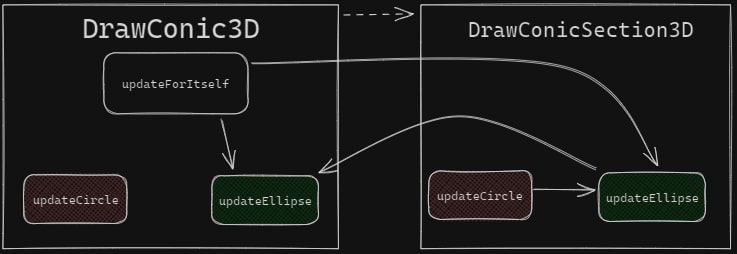
On the one hand, it seems that the developers wanted to use the all-purpose updateEllipse method to draw a circle. On the other hand, it's a bit strange that DrawConicSection3D has the updateCircle method that calls updateEllipse. However, updateCircle will never be called.
It's hard to guess what the fixed code may look like if the error is actually in the code. For example, if updateCircle needs to call updateEllipse in DrawConicSection3D, but DrawConic3D needs a more optimized algorithm for the circle, the fixed scheme might look like this:
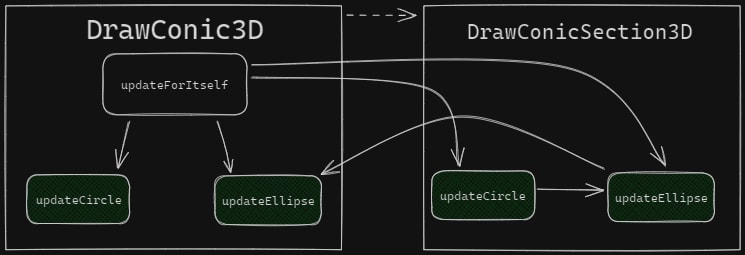
So, it seems that developers once wrote updateCircle and then lost it, and we may have found its intended "home". Looks like we have discovered the ruins of the refactoring after which the developers forgot about the "homeless" method. In any case, it's worth rewriting this code to make it clearer so that we don't end up with so many questions.
All these questions have arisen because of the PVS-Studio warning. That's the warning, by the way:
V6067 Two or more case-branches perform the same actions. DrawConic3D.java 212, DrawConic3D.java 215
Order of missing object
private void updateOrdering(GeoElement geo, ObjectMovement movement) {
....
switch (movement) {
....
case FRONT:
....
if (index == firstIndex) {
if (index != 0) {
geo.setOrdering(orderingDepthMidpoint(index));
}
else {
geo.setOrdering(drawingOrder.get(index - 1).getOrdering() - 1);
}
}
....
}
....
}
We get the following warning:
V6025 Index 'index - 1' is out of bounds. LayerManager.java 393
This is curious because, in the else block, the index variable is guaranteed to get the value 0. So, we pass -1 as an argument to the get method. What's the result? We catch an IndexOutOfBoundsException.
Triangles
@Override
protected int getGLType(Type type) {
switch (type) {
case TRIANGLE_STRIP:
return GL.GL_TRIANGLE_STRIP;
case TRIANGLE_FAN:
return GL.GL_TRIANGLE_STRIP; //
The code is new, but the error is already well-known. It's quite obvious that GL.GL_TRIANGLE_STRIP should be GL.GL_TRIANGLE_FAN instead*.* The methods may be similar in some ways, but the results are different. You can read about it under the spoiler.
V6067 Two or more case-branches perform the same actions. RendererImplShadersD.java 243, RendererImplShadersD.java 245
To describe a series of triangles, we need to save the coordinates of the three vertices of each triangle. Thus, given N triangles, we need the saved 3N vertices. If we describe a polyhedral object using a polygon mesh, it's important to know if the triangles are connected. If they are, we can use the Triangle Strip or the Triangle Fan to describe the set of triangles using N 2 vertices.
We note that the Triangle Fan has been removed in Direct3D 10. In OpenGL 4.6, this primitive still exists.
The Triangle Fan uses one center vertex as common, as well as the last vertex and the new vertex. Look at the following example:
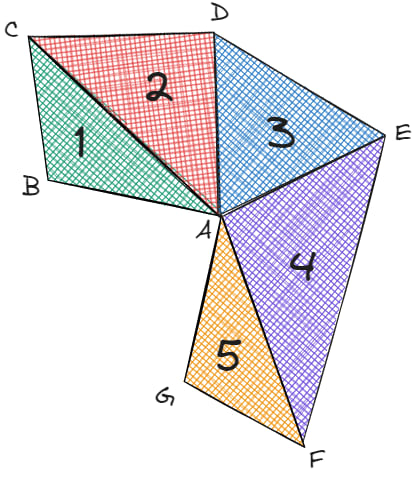
To describe it, we'd need the entry (A, B, C, D, E, F, G). There are five triangles and seven vertices in the entry.
The Triangle Strip uses the last two vertices and a new one. For instance, we can create the image below using the same sequence of vertices:
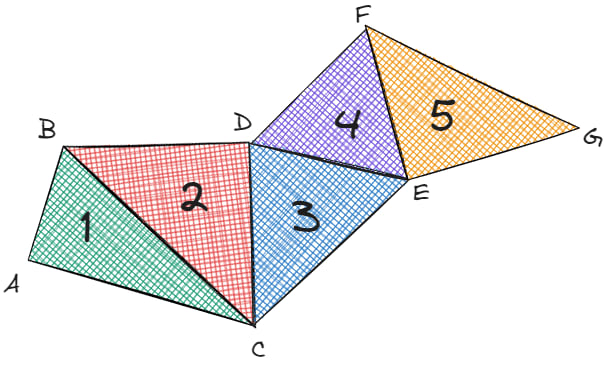
Therefore, if we use the wrong primitive, we'll get dramatically different results.
Overwritten values
public static void addToJsObject(
JsPropertyMap
-
 图片在Chrome中为何仍有边框?`border: none;`无效解决方案在chrome 在使用Chrome and IE9中的图像时遇到的一个频繁的问题是围绕图像的持续薄薄边框,尽管指定了图像,尽管指定了;和“边境:无;”在CSS中。要解决此问题,请考虑以下方法: Chrome具有忽略“ border:none; none;”的已知错误,风格。要解决此问题,请使用以下...编程 发布于2025-07-01
图片在Chrome中为何仍有边框?`border: none;`无效解决方案在chrome 在使用Chrome and IE9中的图像时遇到的一个频繁的问题是围绕图像的持续薄薄边框,尽管指定了图像,尽管指定了;和“边境:无;”在CSS中。要解决此问题,请考虑以下方法: Chrome具有忽略“ border:none; none;”的已知错误,风格。要解决此问题,请使用以下...编程 发布于2025-07-01 -
 如何克服PHP的功能重新定义限制?克服PHP的函数重新定义限制在PHP中,多次定义一个相同名称的函数是一个no-no。尝试这样做,如提供的代码段所示,将导致可怕的“不能重新列出”错误。 但是,PHP工具腰带中有一个隐藏的宝石:runkit扩展。它使您能够灵活地重新定义函数。 runkit_function_renction_re...编程 发布于2025-07-01
如何克服PHP的功能重新定义限制?克服PHP的函数重新定义限制在PHP中,多次定义一个相同名称的函数是一个no-no。尝试这样做,如提供的代码段所示,将导致可怕的“不能重新列出”错误。 但是,PHP工具腰带中有一个隐藏的宝石:runkit扩展。它使您能够灵活地重新定义函数。 runkit_function_renction_re...编程 发布于2025-07-01 -
 Go语言垃圾回收如何处理切片内存?Garbage Collection in Go Slices: A Detailed AnalysisIn Go, a slice is a dynamic array that references an underlying array.使用切片时,了解垃圾收集行为至关重要,以避免潜在的内存泄...编程 发布于2025-07-01
Go语言垃圾回收如何处理切片内存?Garbage Collection in Go Slices: A Detailed AnalysisIn Go, a slice is a dynamic array that references an underlying array.使用切片时,了解垃圾收集行为至关重要,以避免潜在的内存泄...编程 发布于2025-07-01 -
 如何从Python中的字符串中删除表情符号:固定常见错误的初学者指南?从python import codecs import codecs import codecs 导入 text = codecs.decode('这狗\ u0001f602'.encode('utf-8'),'utf-8') 印刷(文字)#带有...编程 发布于2025-07-01
如何从Python中的字符串中删除表情符号:固定常见错误的初学者指南?从python import codecs import codecs import codecs 导入 text = codecs.decode('这狗\ u0001f602'.encode('utf-8'),'utf-8') 印刷(文字)#带有...编程 发布于2025-07-01 -
 C++成员函数指针正确传递方法如何将成员函数置于c 的函数时,接受成员函数指针的函数时,必须同时提供对象的指针,并提供指针和指针到函数。需要具有一定签名的功能指针。要通过成员函数,您需要同时提供对象指针(此)和成员函数指针。这可以通过修改Menubutton :: SetButton()(如下所示:[&& && && &&华)...编程 发布于2025-07-01
C++成员函数指针正确传递方法如何将成员函数置于c 的函数时,接受成员函数指针的函数时,必须同时提供对象的指针,并提供指针和指针到函数。需要具有一定签名的功能指针。要通过成员函数,您需要同时提供对象指针(此)和成员函数指针。这可以通过修改Menubutton :: SetButton()(如下所示:[&& && && &&华)...编程 发布于2025-07-01 -
 如何使用Python的请求和假用户代理绕过网站块?如何使用Python的请求模拟浏览器行为,以及伪造的用户代理提供了一个用户 - 代理标头一个有效方法是提供有效的用户式header,以提供有效的用户 - 设置,该标题可以通过browser和Acterner Systems the equestersystermery和操作系统。通过模仿像Chro...编程 发布于2025-07-01
如何使用Python的请求和假用户代理绕过网站块?如何使用Python的请求模拟浏览器行为,以及伪造的用户代理提供了一个用户 - 代理标头一个有效方法是提供有效的用户式header,以提供有效的用户 - 设置,该标题可以通过browser和Acterner Systems the equestersystermery和操作系统。通过模仿像Chro...编程 发布于2025-07-01 -
 如何有效地转换PHP中的时区?在PHP 利用dateTime对象和functions DateTime对象及其相应的功能别名为时区转换提供方便的方法。例如: //定义用户的时区 date_default_timezone_set('欧洲/伦敦'); //创建DateTime对象 $ dateTime = ne...编程 发布于2025-07-01
如何有效地转换PHP中的时区?在PHP 利用dateTime对象和functions DateTime对象及其相应的功能别名为时区转换提供方便的方法。例如: //定义用户的时区 date_default_timezone_set('欧洲/伦敦'); //创建DateTime对象 $ dateTime = ne...编程 发布于2025-07-01 -
 为什么HTML无法打印页码及解决方案无法在html页面上打印页码? @page规则在@Media内部和外部都无济于事。 HTML:Customization:@page { margin: 10%; @top-center { font-family: sans-serif; font-weight: bo...编程 发布于2025-07-01
为什么HTML无法打印页码及解决方案无法在html页面上打印页码? @page规则在@Media内部和外部都无济于事。 HTML:Customization:@page { margin: 10%; @top-center { font-family: sans-serif; font-weight: bo...编程 发布于2025-07-01 -
 PHP SimpleXML解析带命名空间冒号的XML方法在php 很少,请使用该限制很大,很少有很高。例如:这种技术可确保可以通过遍历XML树和使用儿童()方法()方法的XML树和切换名称空间来访问名称空间内的元素。编程 发布于2025-07-01
PHP SimpleXML解析带命名空间冒号的XML方法在php 很少,请使用该限制很大,很少有很高。例如:这种技术可确保可以通过遍历XML树和使用儿童()方法()方法的XML树和切换名称空间来访问名称空间内的元素。编程 发布于2025-07-01 -
 您可以使用CSS在Chrome和Firefox中染色控制台输出吗?在javascript console 中显示颜色是可以使用chrome的控制台显示彩色文本,例如红色的redors,for for for for错误消息?回答是的,可以使用CSS将颜色添加到Chrome和Firefox中的控制台显示的消息(版本31或更高版本)中。要实现这一目标,请使用以下模...编程 发布于2025-07-01
您可以使用CSS在Chrome和Firefox中染色控制台输出吗?在javascript console 中显示颜色是可以使用chrome的控制台显示彩色文本,例如红色的redors,for for for for错误消息?回答是的,可以使用CSS将颜色添加到Chrome和Firefox中的控制台显示的消息(版本31或更高版本)中。要实现这一目标,请使用以下模...编程 发布于2025-07-01 -
 如何使用Java.net.urlConnection和Multipart/form-data编码使用其他参数上传文件?使用http request 上传文件上传到http server,同时也提交其他参数,java.net.net.urlconnection and Multipart/form-data Encoding是普遍的。 Here's a breakdown of the process:Mu...编程 发布于2025-07-01
如何使用Java.net.urlConnection和Multipart/form-data编码使用其他参数上传文件?使用http request 上传文件上传到http server,同时也提交其他参数,java.net.net.urlconnection and Multipart/form-data Encoding是普遍的。 Here's a breakdown of the process:Mu...编程 发布于2025-07-01 -
 解决MySQL插入Emoji时出现的\\"字符串值错误\\"异常Resolving Incorrect String Value Exception When Inserting EmojiWhen attempting to insert a string containing emoji characters into a MySQL database us...编程 发布于2025-07-01
解决MySQL插入Emoji时出现的\\"字符串值错误\\"异常Resolving Incorrect String Value Exception When Inserting EmojiWhen attempting to insert a string containing emoji characters into a MySQL database us...编程 发布于2025-07-01 -
 FastAPI自定义404页面创建指南response = await call_next(request) if response.status_code == 404: return RedirectResponse("https://fastapi.tiangolo.com") else: ...编程 发布于2025-07-01
FastAPI自定义404页面创建指南response = await call_next(request) if response.status_code == 404: return RedirectResponse("https://fastapi.tiangolo.com") else: ...编程 发布于2025-07-01 -
 JavaScript计算两个日期之间天数的方法How to Calculate the Difference Between Dates in JavascriptAs you attempt to determine the difference between two dates in Javascript, consider this s...编程 发布于2025-07-01
JavaScript计算两个日期之间天数的方法How to Calculate the Difference Between Dates in JavascriptAs you attempt to determine the difference between two dates in Javascript, consider this s...编程 发布于2025-07-01 -
 Java中假唤醒真的会发生吗?在Java中的浪费唤醒:真实性或神话?在Java同步中伪装唤醒的概念已经是讨论的主题。尽管存在这种行为的潜力,但问题仍然存在:它们实际上是在实践中发生的吗? Linux的唤醒机制根据Wikipedia关于伪造唤醒的文章,linux实现了pthread_cond_wait()功能的Linux实现,利用...编程 发布于2025-07-01
Java中假唤醒真的会发生吗?在Java中的浪费唤醒:真实性或神话?在Java同步中伪装唤醒的概念已经是讨论的主题。尽管存在这种行为的潜力,但问题仍然存在:它们实际上是在实践中发生的吗? Linux的唤醒机制根据Wikipedia关于伪造唤醒的文章,linux实现了pthread_cond_wait()功能的Linux实现,利用...编程 发布于2025-07-01
学习中文
- 1 走路用中文怎么说?走路中文发音,走路中文学习
- 2 坐飞机用中文怎么说?坐飞机中文发音,坐飞机中文学习
- 3 坐火车用中文怎么说?坐火车中文发音,坐火车中文学习
- 4 坐车用中文怎么说?坐车中文发音,坐车中文学习
- 5 开车用中文怎么说?开车中文发音,开车中文学习
- 6 游泳用中文怎么说?游泳中文发音,游泳中文学习
- 7 骑自行车用中文怎么说?骑自行车中文发音,骑自行车中文学习
- 8 你好用中文怎么说?你好中文发音,你好中文学习
- 9 谢谢用中文怎么说?谢谢中文发音,谢谢中文学习
- 10 How to say goodbye in Chinese? 再见Chinese pronunciation, 再见Chinese learning

























